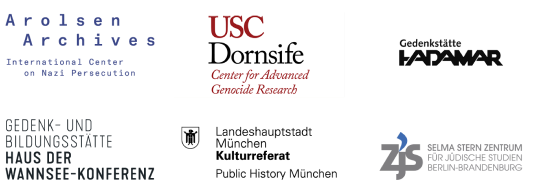Asperg
05/22/1940
The photo shows the deportees with luggage waiting in a street. It is not possible to determine exactly where or when this photo was taken. As some of the people are sitting down to rest, the picture was probably taken after their march to the assembly camp.
Annotations
Historical context
Deportation von Asperg nach Jędrzejów im Mai 1940
In the early morning hours of May 16, 1940, arrests began in Mainz, Worms and Ingelheim. The people who were arrested were taken to Hohenasperg on a special train. There, staff from the so-called Rassehygienische Forschungsstelle (racial hygiene research center) carried out an “examination,” which was crucial for the decision on whether or not a person would be deported. People were deprived of their ID cards; they were photographed. On May 22, they were deported to the General Government. The internment lasted three days longer than planned. The so-called racial-biological examinations and the lack of local police lists had delayed the process from the police's point of view, as is described in a detailed report written by the Darmstadt criminal investigations police that has survived.
The train headed for Jędrzejów in the Radom district. A total of 490 deported people were taken from there to camps and ghettos to perform forced labor. The individual fates are difficult to retrace. Many died of hunger, disease, or mistreatment; others were systematically murdered by the Nazis in the context of so-called operations.
Sources
About the image series
At least 15 color slides have survived from Asperg. The pictures show the march to the assembly camp in Hohenasperg Fortress, the stay in the courtyard, and the train’s departure. The photos span the 6 days between arrest, arrival at the assembly camp, and deportation. Only the first and last photos of the series can be placed in this chronological sequence with certainty. The high number of children among the deportees is striking. All the pictures were taken outdoors. No photographs of the preceding arrests or of the degrading examinations and procedures at the assembly camp have survived. The documentary and bureaucratic character of the images is striking from a stylistic point of view. Maybe the photos were taken to supplement the report on the deportation written by the criminal investigations police in Darmstadt. The prominent place given to police officers armed with guns in several of the pictures lends credence to this idea.
Photographer
Unknown, Police man
It is almost certain that the photographer was a police officer involved in the crime. The photographs are supposed to make it look as if the deportation was “duly” executed and confirm the impression that the Darmstadt police report is intended to create as well. From the persecutees’ point of view, essential steps in the deportation process have not been staged or documented, such as the degrading medical examinations in the context of the so-called racial-biological expert opinions.
Provenance
The photos have been preserved at the Bundesarchiv (Federal Archives) in collection R 165, the files of the "racial hygiene and criminal biological research center of the Reich health service.” They are part of a larger collection which includes many photographs. The photos were in the estate of Robert Ritter, the head of this institution, which played an important role in the persecution of Sinti and Roma. However, it is particularly difficult to retrace the provenance of collection R 165, not all of which has been preserved. Most notably, the "expert opinions" of the research center have disappeared or been destroyed. After 1945, some parts of the files were used by the police and by private and university researchers. In 1981, the civil rights movement of the Sinti and Roma occupied the archives of Tübingen University to enforce their demand that the extant files be incorporated into the holdings of the Bundesarchiv.
Call number at source archive
R 165 Bild 244-49
Title at source archive
Asperg. Deportation von Sinti und Roma, Sammelplatz
Acknowledgements
We would like to cordially thank Frank Reuter for his support of the project. Mr. Reuter’s research forms the basis of this short presentation. Research conducted by Wolfgang Wippermann in the 1980s deserves special mention as well.
Text and research by Malte Grünkorn.
Kooperationsverbund #LastSeen. Bilder der NS-Deportationen Dr. Alina Bothe Projektleiterin
c/o Selma Stern Zentrum für Jüdische Studien Berlin-Brandenburg
Freie Universität Berlin
Habelschwerdter Allee 34A
14195 Berlin
lastseen@zedat.fu-berlin.de
Ein Kooperationsprojekt von

Gefördert durch

Datenschutz | Impressum